
February 03, 2025
Canyon Resources Limited (ASX: CAY) (‘Canyon’ or the ‘Company’) is pleased to announce that the location of its Inland Rail Facility (‘IRF’) has been approved by the Government of Cameroon. In addition, Canyon’s in- country subsidiary Camalco Cameroon SA (‘Camalco’) has been allocated 105 hectares of land by the Lamido of Ngaoundere to be used for future additions to the IRF and associated infrastructure.
The signing of this land approval marks another major milestone achieved by the Company in the rapid development of the Minim Martap Bauxite Project (‘Minim Martap’ or ‘the Project’).
The approved IRF location is strategically situated near the existing Makor Railway Station, enabling seamless integration with existing local infrastructure and enhancing construction efficiency. The timing of the approval for the IRF location and allocation of additional land, comes shortly after the underwriting agreement with Eagle Eye Asset Holdings Pte Ltd (‘EEA’) to finance the purchase rolling stock for the development of Minim Martap.
The rapid succession of these milestones underscores the strong commitment of Canyon’s major shareholder, EEA, and dedication of relevant authorities in Cameroon, to advance Minim Martap towards production status.
Canyon is focused on progressing key logistical and infrastructure solutions to further de-risk the Project and support the ongoing Definitive Feasibility Study (‘DFS’). Upon completion and at the commencement of production, the IRF will be used as a loading station for wagons of Bauxite ore brought by road from Minim Martap before transport via the main rail line to port, using the Company’s own rolling stock.
Mr Jean Sebastien Boutet, Canyon Chief Executive Officer commented: “The approval for the location of the Inland Rail Facility is a timely achievement for the Company following the recently announced underwriting agreement with EEA to finance the purchase of rolling stock. Key details from these agreements are being factored into the ongoing Definitive Feasibility Study and the increased oversight of logistics provides Canyon stability in progressing our Project.
“I would like to extend my gratitude to his Excellency, Lamido of Ngaoundere, for his generous provision of land in the Makor region. Access to an additional 105 hectares surrounding the IRF site provides the Company with assurance to construct and develop the IRF and other critical infrastructure for Minim Martap, reinforcing the Project’s long-term viability.
“The past six months have been transformative for Canyon, with initial infrastructure solutions in place and strong support from strategic partners and government, we have rapidly derisked the Project’s development.
“The support we’ve received from EEA, the Government of Cameroon, and key stakeholders reflects the enormous opportunity that Minim Martap presents to Cameroon and local communities. The broader bauxite market remains in a highly resilient environment, and we look forward to becoming a key supplier of this critical mineral to future offtake partners.”
Click here for the full ASX Release
This article includes content from Canyon Resources Limited, licensed for the purpose of publishing on Investing News Australia. This article does not constitute financial product advice. It is your responsibility to perform proper due diligence before acting upon any information provided here. Please refer to our full disclaimer here.
The Conversation (0)
01 December
Australia Minerals Council Blasts EPBC Bill’s Lack of Environment and Mining Balance
“The deal between the Federal Government and the Greens to pass the Environment Protection Reform Bill 2025 and related bills is an inferior and disappointing outcome which fails to strike the right balance between protecting Australia’s unique environment while enabling responsible and... Keep Reading...
28 November
Completion of the Acquisition of the Webbs Consol Silver Project
Rapid Critical Metals Limited (‘Rapid,’ ‘RCM’ or ‘Company’) is pleased to announce that it has completed the acquisition of the Webbs Consol Silver Project (Webbs Consol) in northeast New South Wales, comprising EL 8933 and EL 9454 from Lode Resources Limited (ASX: LDR) (Lode Resources). The... Keep Reading...
19 November
Red Mountain Mining Successfully Lists on the US Stock Market with a Strong Trading Debut Up 36%
Red Mountain Mining Limited (ASX: RMX, US CODE: RMXFF, or “Company”), a Critical Minerals exploration and development company with a growing portfolio in Tier-1 Mining Districts in the United States and Australia, is pleased to announce that RMXFF successfully commenced trading on the OTCQB this... Keep Reading...
18 November
Steve Barton: Mining Stocks — How I Pick Winners, When to Buy and Sell
Steve Barton, host of In It To Win It, shares how he picks mining stocks, running through his initial screening process for companies, as well as the questions he asks CEOs.He also explains how he decides when to buy and when to sell.Don't forget to follow us @INN_Resource for real-time... Keep Reading...
10 November
Lunar Mining Set to Favor Established Miners Over Startups, Analyst Says
As humanity edges closer to mining the moon, industry analysts warn that established mining companies, not venture-backed space startups, may dominate the emerging lunar resource sector. The space mining market, projected to reach US$20 billion by 2035, has attracted significant attention from... Keep Reading...
31 October
Red Cloud Announces Keynote Lineup and Agenda for 2025 Fall Mining Showcase
Red Cloud is excited to announce the agenda and keynote lineup for its annual Fall Mining Showcase, taking place November 4 & 5, 2025 at the Sheraton Centre Toronto Hotel. This flagship event will bring together over 80 mining and exploration companies, along with leading investors, analysts,... Keep Reading...
Latest News
Latest Press Releases
Related News
TOP STOCKS
American Battery4.030.24
Aion Therapeutic0.10-0.01
Cybin Corp2.140.00





